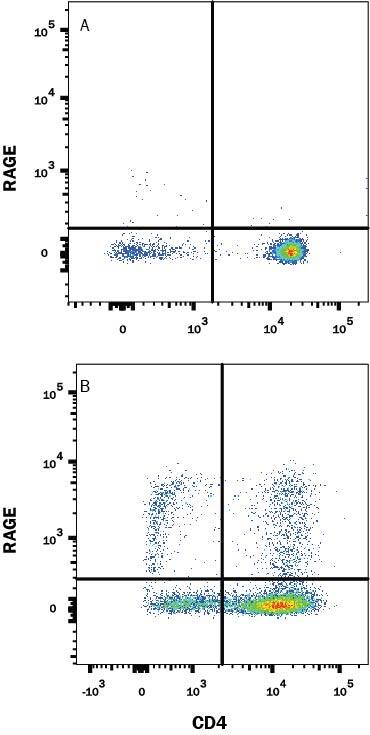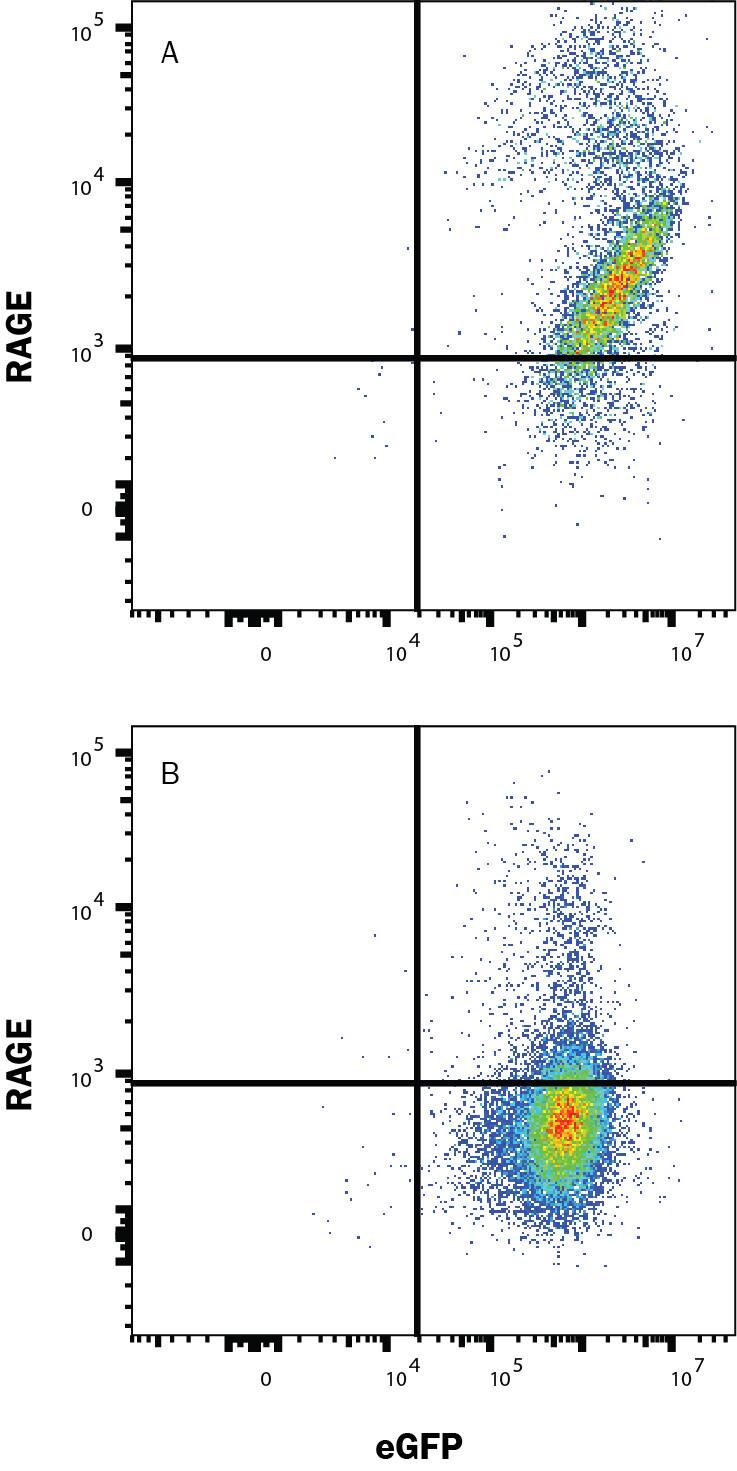Mouse RAGE/AGER Alexa Fluor® 647-conjugated Antibody
R&D Systems, part of Bio-Techne | Catalog # FAB11795R


Key Product Details
Species Reactivity
Applications
Label
Antibody Source
Product Specifications
Immunogen
Gly23-Leu342
Accession # NP_031451
Specificity
Clonality
Host
Isotype
Scientific Data Images for Mouse RAGE/AGER Alexa Fluor® 647-conjugated Antibody
Detection of RAGE in Mouse Splenocytes by Flow Cytometry.
Mouse splenocytes either (A) unstimulated or (B) stimulated to induce Th1 cells were stained with Rat Anti-Mouse RAGE Alexa Fluor® 647-conjugated Monoclonal Antibody (Catalog # FAB11795R) and Rat Anti-Mouse CD4 PE-conjugated Monoclonal Antibody (FAB554P). Quadrant markers were set based on control antibody staining (IC006R). View our protocol for Staining Membrane-associated Proteins.Detection of RAGE/AGER in HEK293 cells by Flow Cytometry.
HEK293 cells transfected with mRAGE and eGFP (A) vs irrelevant and eGFP (B) were stained with Rat Anti-Mouse RAGE/AGER Alexa Fluor® 647-conjugated Monoclonal Antibody (Catalog # FAB11795R). View our protocol for Staining Membrane-associated Proteins.Applications for Mouse RAGE/AGER Alexa Fluor® 647-conjugated Antibody
Flow Cytometry
Reviewed Applications
Read 1 review rated 4 using FAB11795R in the following applications:
Formulation, Preparation, and Storage
Purification
Formulation
Shipping
Stability & Storage
- 12 months from date of receipt, 2 to 8 °C as supplied.
Background: RAGE/AGER
Advanced glycation endproducts (AGE) are adducts formed by the non-enzymatic glycation or oxidation of macromolecules (1). AGE forms during aging and its formation is accelerated under pathophysiologic states such as diabetes, Alzheimer’s disease, renal failure and immune/inflammatory disorders. Receptor for Advanced Glycation Endoproducts (RAGE), named for its ability to bind AGE, is a multiligand receptor belonging the immunoglobulin (Ig) superfamily. Besides AGE, RAGE binds amyloid beta-peptide, S100/calgranulin family proteins, high mobility group B1 (HMGB1, also know as amphoterin) and leukocyte integrins (1, 2).
The mouse RAGE gene encodes a 403 amino acid (aa) residue type I transmembrane glycoprotein with a 22 aa signal peptide, a 319 aa extracellular domain containing a Ig-like V-type domain and two Ig-like Ce-type domains, a 21 aa transmembrane domain and a 41 aa cytoplasmic domain (3). The V-type domain and the cytoplasmic domain are important for ligand binding and for intracellular signaling, respectively. Two alternative splice variants, lacking the V-type domain or the cytoplasmic tail, are known (1, 4). RAGE is highly expressed in the embryonic central nervous system (5). In adult tissues, RAGE is expressed at low levels in multiple tissues including endothelial and smooth muscle cells, mononuclear phagocytes, pericytes, microglia, neurons, cardiac myocytes and hepatocytes (6). The expression of RAGE is upregulated upon ligand interaction. Depending on the cellular context and interacting ligand, RAGE activation can trigger differential signaling pathways that affect divergent pathways of gene expression (1, 7). RAGE activation modulates varied essential cellular responses (including inflammation, immunity, proliferation, cellular adhesion and migration) that contribute to cellular dysfunction associated with chronic diseases such as diabetes, cancer, amyloidoses and immune or inflammatory disorders (1).
References
- Schmidt, A. et al. (2001) J. Clin. Invest. 108:949.
- Chavakis, T. et al. (2003) J. Exp. Med. 198:507.
- Renard, C. et al. (1997) Mol. Pharmacol. 52:54.
- Yonekura, H. et al. (2003) Biochem. J. 370:1097.
- Hori, O. et al. (1995) J. Biol. Chem. 270:25752.
- Brett, J. et al. (1993) Am. J. Pathol. 143:1699.
- Valencia, J.V. et al. (2004) Diabetes 53:743.
Long Name
Alternate Names
Gene Symbol
UniProt
Additional RAGE/AGER Products
Product Specific Notices for Mouse RAGE/AGER Alexa Fluor® 647-conjugated Antibody
This product is provided under an agreement between Life Technologies Corporation and R&D Systems, Inc, and the manufacture, use, sale or import of this product is subject to one or more US patents and corresponding non-US equivalents, owned by Life Technologies Corporation and its affiliates. The purchase of this product conveys to the buyer the non-transferable right to use the purchased amount of the product and components of the product only in research conducted by the buyer (whether the buyer is an academic or for-profit entity). The sale of this product is expressly conditioned on the buyer not using the product or its components (1) in manufacturing; (2) to provide a service, information, or data to an unaffiliated third party for payment; (3) for therapeutic, diagnostic or prophylactic purposes; (4) to resell, sell, or otherwise transfer this product or its components to any third party, or for any other commercial purpose. Life Technologies Corporation will not assert a claim against the buyer of the infringement of the above patents based on the manufacture, use or sale of a commercial product developed in research by the buyer in which this product or its components was employed, provided that neither this product nor any of its components was used in the manufacture of such product. For information on purchasing a license to this product for purposes other than research, contact Life Technologies Corporation, Cell Analysis Business Unit, Business Development, 29851 Willow Creek Road, Eugene, OR 97402, Tel: (541) 465-8300. Fax: (541) 335-0354.
For research use only
